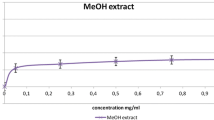Summary
The objective of the present investigation was to establish whether a known lymphoreticular-stimulating agent Corynebacterium parvum would augment the established antitumor activity of α-difluoromethylornithine in vivo. Furthermore, since C. parvum is known to boost cell mediated cytotoxicity, the effect of DFMO (DL-α-difluoromethylornithine·HCl·H2O) treatment was evaluated on macrophage and natural killer (NK) cell tumoricidal activity. DFMO administered alone, 1% or 2% in drinking water, inhibited 49.4% or 88.0% of B16 melanoma growth in vivo, respectively. Administration of C. parvum alone, three doses of 300 μg each, inhibited tumor growth 57.4%. When administered together, DFMO and C. parvum treatment resulted in 89.8% (1% DFMO) or 97.4% (2% DFMO) inhibition of melanoma growth depending upon the dose of DFMO. C. parvum-treated animals had increased levels of macrophage-mediated tumoricidal activity directed against B16 melanoma cells in vitro, however, NK cell activity was reduced. DFMO treatment alone had no effect on macrophage or NK cell tumoricidal activity. In animals receiving both C. parvum and DFMO treatments macrophage-mediated tumoricidal activity was augmented. These results demonstrate that C. parvum can augment the antitumor activity of DFMO in vivo, possibly through macrophage activation. Furthermore, in contrast to many other cancer chemotherapeutic drugs, DFMO is apparently not immunosuppressive regarding tumoricidal effector cells.
Similar content being viewed by others
References
Bartholeyns J (1983) Treatment of metastatic Lewis lung carcinoma with DL-α-difluoromethylornithine. Eur J Cancer Clin Oncol 19:567
Fozard JR, Part M-L, Prakash NJ, Grove J, Schechter P, Sjoerdsma A, Koch-Weser J (1980) L-Ornithine decarboxylase: an essential role in early mammalian embryogenesis. Science (Wash. D.C.) 208:505
Ghaffar A, Cullen RT, Dunbar N, Woodruff MFA (1974) Antitumor effect in vitro of lymphocytes and macrophages from mice treated with Corynebacterium parvum. Br J Cancer 29:199
Hanna N (1982) Inhibition of experimental tumor metastasis by selective activation of natural killer cells. Cancer Res 42:1337
Heby O (1981) Role of polyamines in the control of cell proliferation and differentiation. Differentiation 19:1
Herberman RB, Nunn ME, Holden HT, Staal S, Djue JY (1977) Augmentation of natural cytotoxic reactivity of mouse lymphoid cells against syngeneic and allogeneic target cells. Int J Cancer 19:555
Luk GD, Goodwin G, Marton LJ, Baylin SB (1981) Polyamines are necessary for the survival of human small-cell lung carcinoma in culture. Proc Natl Acad Sci 78:2355
Mamont PS, Duchesne MC, Grove J, Bey P (1978) Anti-proliferative properties of DL-α-difluoromethyl ornithine in cultured cells. A consequence of irreversible inhibition of ornithine decarboxylase. Biochem Biophys Res Commun 81:58
Marton LJ, Levin VA, Hervatin SJ, Koch-Weser J, McCann PP, Sjoerdsma A (1981) Potentiation of the antitumor therapeutic effects of 1,3-bis(2-chloroethyl-1-nitroso urea) by α-difluoromethyl ornithine, an ornithine decarboxylase inhibitor. Cancer Res 41:4426
Metcalf BW, Bey P, Danzin C, Jung MJ, Casara P, Vevert JP (1978) Catalytic irreversible inhibition of mammalian ornithine decarboxylase (ECH111F) by substrate and product analogues. J Am Chem Soc 100:2551
Milas L, Scott MT (1978) Antitumor activity of Corynebacterium parvum. Adv Cancer Res 26:257
Olivotto M, Bomford R (1974) In vitro inhibition of tumor cell growth and DNA synthesis by peritoneal and lung macrophages from mice injected with Corynebacterium parvum. Int J Cancer 13:478
Pegg AE, Williams-Ashman HG (1968) Biosynthesis of putrescine in the prostate gland of the rat. Biochem J 108:533
Prakash NJ, Schechter PJ, Mamont PS, Grove J, Kock-Weser J, Sjoerdsma A (1980) Inhibition of EMT6 tumor growth by interference with polyamine biosynthesis: Effects of α-difluoromethyl ornithine, an irreversible inhibitor of ornithine decarboxylase. Life Sci 26:181
Savary CA, Lotzova E (1978) Suppression of natural killer cell cytotoxicity by splenocytes from Corynebacterium parvum injected, bone marrow-tolerant, and infant mice. J Immunol 120:239
Seidenfeld J, Gray JW, Marton LJ (1981) Depletion of 9L rat brain tumor cell polyamine content by treatment with DL-α-difluoromethyl ornithine inhibits proliferation and the G1 to S transition. Exp Cell Res 131:209
Seiler N (1970) Use of the dansyl reaction in biochemical analysis. Meth Biochem Anal 18:259
Sugiyama M, Epstein L (1978) Effect of Corynebacterium parvum on human T-lymphocyte interferon production and T-lymphocyte proliferation in vitro. Cancer Res 38:4467
Sunkara PS, Rao PN (1981) Differential cell cycle response of normal and transformed cells to polyamine limitation. Adv Polyamine Res 3:347
Sunkara PS, Prakash NJ, Rosenberger AL (1982) An essential role for polyamines in tumor metastases. FEBS Lett 150:397
Sunkara PS, Prakash NJ, Mayer GD, Sjoerdsma A (1983) Tumor suppression with a combination of α-difluoromethyl ornithine and interferon. Science 219:851
Svedersky L, Benton C, Berger W, Rinderknecht E, Harlein R, Palladino M (1984) Biological and antigenic similarities of murine interferon-gamma and macrophage-activating factor. J Exp Med 159:812
Verma DW, Sunkara PS (1982) An essential role for polyamine biosynthesis during human granulopoietic differentiation. Cancer Res 42:3046
Author information
Authors and Affiliations
Rights and permissions
About this article
Cite this article
Bowlin, T.L., Rosenberger, A.L. & Sunkara, P.S. The effect of combination treatment with alpha-difluoromethylornithine and Corynebacterium parvum on B16 melanoma growth and tumoricidal effector cell generation in vivo. Cancer Immunol Immunother 20, 214–218 (1985). https://doi.org/10.1007/BF00205579
Received:
Accepted:
Issue Date:
DOI: https://doi.org/10.1007/BF00205579




